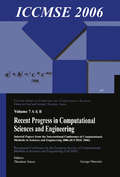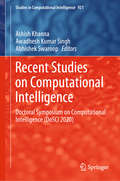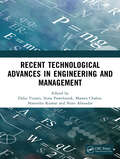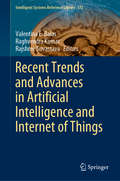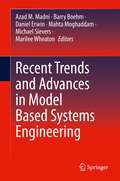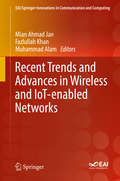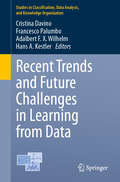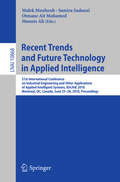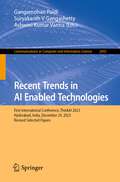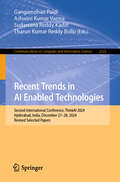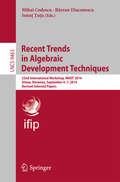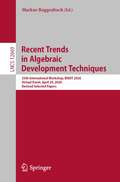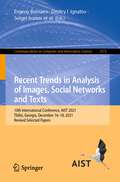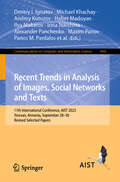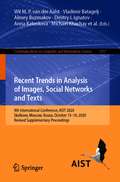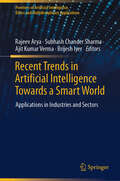- Table View
- List View
Recent Progress in Computational Sciences and Engineering (2 vols)
by Theodore SimosThis volume brings together selected contributed papers presented at the International Conference of Computational Methods in Science and Engineering (ICCMSE 2006), held in Chania, Greece, October 2006. The conference aims to bring together computational scientists from several disciplines in order to share methods and ideas. The ICCMSE is unique in its kind. It regroups original contributions from all fields of the traditional Sciences, Mathematics, Physics, Chemistry, Biology, Medicine and all branches of Engineering. It would be perhaps more appropriate to define the ICCMSE as a conference on computational science and its applications to science and engineering. Topics of general interest are: Computational Mathematics, Theoretical Physics and Theoretical Chemistry. Computational Engineering and Mechanics, Computational Biology and Medicine, Computational Geosciences and Meteorology, Computational Economics and Finance, Scientific Computation. High Performance Computing, Parallel and Distributed Computing, Visualization, Problem Solving Environments, Numerical Algorithms, Modelling and Simulation of Complex System, Web-based Simulation and Computing, Grid-based Simulation and Computing, Fuzzy Logic, Hybrid Computational Methods, Data Mining, Information Retrieval and Virtual Reality, Reliable Computing, Image Processing, Computational Science and Education etc. More than 800 extended abstracts have been submitted for consideration for presentation in ICCMSE 2005. From these 500 have been selected after international peer review by at least two independent reviewers.
Recent Research in Control Engineering and Decision Making (Studies in Systems, Decision and Control #199)
by Vladik Kreinovich Olga Dolinina Alexander Brovko Vitaly Pechenkin Alexey Lvov Vadim ZhmudThis book constitutes the full papers and short monographs developed on the base of the refereed proceedings of the International Conference on Information Technologies: Information and Communication Technologies for Research and Industry (ICIT-2019), held in Saratov, Russia in February 2019.The book brings accepted papers which present new approaches and methods of solving problems in the sphere of control engineering and decision making for the various fields of studies: industry and research, ontology-based data simulation, smart city technologies, theory and use of digital signal processing, cognitive systems, robotics, cybernetics, automation control theory, image recognition technologies, and computer vision.Particular emphasis is laid on modern trends, new approaches, algorithms and methods in selected fields of interest.The presented papers were accepted after careful reviews made by at least three independent reviewers in a double-blind way. The acceptance level was about 60%. The chapters are organized thematically in several areas within the following tracks:• Models, Methods & Approaches in Decision Making Systems• Mathematical Modelling for Industry & Research• Smart City TechnologiesThe conference is focused on development and globalization of information and communication technologies (ICT), methods of control engineering and decision making along with innovations and networking, ICT for sustainable development and technological change, and global challenges. Moreover, the ICIT-2019 served as a discussion area for the actual above-mentioned topics.The editors believe that the readers will find the proceedings interesting and useful for their own research work.
Recent Research in Control Engineering and Decision Making: Volume 2, 2020 (Studies in Systems, Decision and Control #337)
by Vladik Kreinovich Olga Dolinina Alexander Brovko Vitaly Pechenkin Alexey Lvov Vadim Zhmud Igor BessmertnyThis book constitutes the full research papers and short monographs developed on the base of the refereed proceedings of the International Conference: Information and Communication Technologies for Research and Industry (ICIT 2020). The book brings accepted research papers which present mathematical modelling, innovative approaches and methods of solving problems in the sphere of control engineering and decision making for the various fields of studies: industry and research, energy efficiency and sustainability, ontology-based data simulation, theory and use of digital signal processing, cognitive systems, robotics, cybernetics, automation control theory, image and sound processing, image recognition, technologies, and computer vision. The book contains also several analytical reviews on using smart city technologies in Russia. The central audience of the book are researchers, industrial practitioners and students from the following areas: Adaptive Systems, Human–Robot Interaction, Artificial Intelligence, Smart City and Internet of Things, Information Systems, Mathematical Modelling, and the Information Sciences.
Recent Studies on Computational Intelligence: Doctoral Symposium on Computational Intelligence (DoSCI 2020) (Studies in Computational Intelligence #921)
by Ashish Khanna Awadhesh Kumar Singh Abhishek SwaroopThis book gathers the latest quality research work of Ph.D. students working on the current areas presented in the Doctoral Symposium on Computational Intelligence (DoSCI 2020). The book includes works in the areas of artificial intelligence, deep learning, evolutionary algorithms, swarm intelligence, fuzzy sets and vague sets, rough set theoretic approaches, quantum-inspired computational intelligence, hybrid computational intelligence, machine learning, computer vision, soft computing, distributed computing, parallel and grid computing, cloud computing, high-performance computing, biomedical computing, decision support and decision making. The book is useful for researchers, students, engineers, practitioners and academicians in their advance studies.
Recent Technological Advances in Engineering and Management: Proceedings of recent technological advances in engineering and management
by Narendra KumarIt is with immense pleasure that we extend a warm welcome to all of you to the recently concluded conference, international conference on Advances in Science, Technology and Management (ICOSTEM 2023) which took place from November 24 – 27, 2023, in the picturesque Maldives, Male. This significant event focused on the “Recent Technological Advances in Engineering and Management” with special sessions on Applied Sciences, Management and Engineering.
Recent Trends In Peripheral Security Systems (Services and Business Process Reengineering)
by Dipankar Deb Abhishek Rawat Jatin UpadhyayThis book covers selected topics and methods for peripheral security, which are gaining attention nowadays. The book discusses the security arrangement and methods for monitoring the inside/outside entry of peripheral areas that need to be secured. It relates to a periphery, often portable device (as well as the methods employed, and systems including such a peripheral device and a host central command device with which the local geographical command device communicates), enabling one or more security operations performed by the peripheral device. It also covers the security scenario of snow-prone areas in a remote location. It also elaborates how we can secure the person and devices in extremely cold conditions and rescue them. This book helps the researchers, academicians, and industry persons working in security areas to protect unauthentic entry in large scale areas that may be defense camps or civilian applications like large-sized bungalows, institutes, and organizations of national importance. The experimental results are in close conformance to the proposed methodologies.
Recent Trends and Advances in Artificial Intelligence and Internet of Things (Intelligent Systems Reference Library #172)
by Raghvendra Kumar Valentina E. Balas Rajshree SrivastavaThis book covers all the emerging trends in artificial intelligence (AI) and the Internet of Things (IoT). The Internet of Things is a term that has been introduced in recent years to define devices that are able to connect and transfer data to other devices via the Internet. While IoT and sensors have the ability to harness large volumes of data, AI can learn patterns in the data and quickly extract insights in order to automate tasks for a variety of business benefits. Machine learning, an AI technology, brings the ability to automatically identify patterns and detect anomalies in the data that smart sensors and devices generate, and it can have significant advantages over traditional business intelligence tools for analyzing IoT data, including being able to make operational predictions up to 20 times earlier and with greater accuracy than threshold-based monitoring systems. Further, other AI technologies, such as speech recognition and computer vision can help extract insights from data that used to require human review. The powerful combination of AI and IoT technology is helping to avoid unplanned downtime, increase operating efficiency, enable new products and services, and enhance risk management.
Recent Trends and Advances in Artificial Intelligence: Selected Papers from ICAETA-2024 (Lecture Notes in Networks and Systems #1138)
by Akhtar Jamil Alaa Ali Hameed Alessandro Ortis Isaac Segovia Ramirez Fausto P. GarciaThis book presents a curated selection of papers from the International Conference on Advanced Engineering, Technology, and Applications (ICAETA24), hosted by the University of Catania, Italy, in March 2024. The conference is co-organized by Istinye University, Turkey. The book delves into the forefront of technological advancements, spotlighting the latest trends and applications of artificial intelligence across diverse domains and addressing real-world challenges with transformative solutions. Readers will gain insights into state-of-the-art models and methodologies, particularly focusing on their applications on benchmark datasets. The discussions and presentations within this volume are organized around four pivotal tracks: Artificial Intelligence and Machine Learning, Big Data and Cloud Computing, Internet of Things and Sensor Technology, and Applications of Artificial Intelligence. Each track offers a deep dive into its respective domain, exploring the profound impact of technological innovations on various industries and sectors.
Recent Trends and Advances in Model Based Systems Engineering
by Azad M. Madni Barry Boehm Daniel Erwin Mahta Moghaddam Michael Sievers Marilee WheatonThis volume comprises papers from the 18th Conference on Systems Engineering Research (CSER). The theme of this volume, “Recent Trends and Advances in Model-Based Systems Engineering,” reflects the fact that systems engineering is undergoing a transformation motivated by mission and system complexity and enabled by technological advances such as model-based systems engineering, digital engineering, and the convergence of systems engineering with other disciplines. This conference is focused on exploring recent trends and advances in model-based systems engineering (MBSE) and the synergy of MBSE with simulation technology and digital engineering. Contributors have submitted papers on MBSE methods, modeling approaches, integration of digital engineering with MBSE, standards, modeling languages, ontologies and metamodels, and economics analysis of MBSE to respond to the challenges posed by 21st century systems. What distinguishes this volume are the latest advances in MBSE research, the convergence of MBSE with digital engineering, and recent advances in applied research in MBSE, including growing convergence with systems science and decision science. This volume is appropriate as a reference text in graduate engineering courses in Model-Based Systems Engineering.
Recent Trends and Advances in Wireless and IoT-enabled Networks (EAI/Springer Innovations in Communication and Computing)
by Muhammad Alam Fazlullah Khan Mian Ahmad JanThe book covers a variety of topics in Information and Communications Technology (ICT) and their impact on innovation and business. The authors discuss various innovations, business and industrial motivations, and impact on humans and the interplay between those factors in terms of finance, demand, and competition. Topics discussed include the convergence of Machine to Machine (M2M), Internet of Things (IoT), Social, and Big Data. They also discuss AI and its integration into technologies from machine learning, predictive analytics, security software, to intelligent agents, and many more. Contributions come from academics and professionals around the world.Covers the most recent practices in ICT related topics pertaining to technological growth, innovation, and business;Presents a survey on the most recent technological areas revolutionizing how humans communicate and interact;Features four sections: IoT, Wireless Ad Hoc & Sensor Networks, Fog Computing, and Big Data Analytics.
Recent Trends and Applications of Soft Computing in Engineering (Lecture Notes in Networks and Systems #1273)
by Benjamin Duraković Ali Abd Almisreb Jasmin ŠutkovićRecent Trends and Applications of Soft Computing in Engineering (RTASCE), a key resource showcasing research and development in engineering. Created at the inaugural RTASCE conference in Sarajevo, this edited volume brings together leading scholars and researchers to explore the transformative applications of soft computing in a variety of fields. With topics ranging from artificial intelligence and the Internet of Things (IoT) to machine learning, this book offers practical applications and insight into future trends, making it an invaluable addition to any academic library. This book bridges the biological sciences and engineering through programming, encouraging interdisciplinary collaboration. Structured into five main sections – including artificial intelligence, IoT, communication systems, bioengineering and manufacturing management – RTASCE not only highlights real-world case studies and expert perspectives, but also provides practical guidance for practitioners looking to integrate soft computing techniques into their work .
Recent Trends and Future Challenges in Learning from Data (Studies in Classification, Data Analysis, and Knowledge Organization)
by Francesco Palumbo Cristina Davino Hans A. Kestler Adalbert F. X. WilhelmThis book collects together selected peer-reviewed contributions presented at the European Conference on Data Analysis, ECDA 2022, held in Naples, Italy, September 14-16, 2022. Highlighting the role of statistics in discovering novel and interesting patterns in the era of big data, it follows the motto of the conference: “Avoiding drowning in the data: recent trends and future challenges in learning from data”. The central focus is on multidisciplinary approaches to data analysis, classification, and the interface between computer science, data mining and statistics. Both methodological and applied topics are covered. The former includes supervised and unsupervised techniques with particular emphasis on advances in regression and clustering analysis and constructing composite indicators. The applications are mainly in risk analysis, biology, and education. The volume is organized into four main macro themes: methodological contributions in the social sciences and education, multivariate analysis methods for big data, innovative contributions for applications inspired by biology, and strategies for analyzing complex data in finance.
Recent Trends and Future Technology in Applied Intelligence: 31st International Conference on Industrial Engineering and Other Applications of Applied Intelligent Systems, IEA/AIE 2018, Montreal, QC, Canada, June 25-28, 2018, Proceedings (Lecture Notes in Computer Science #10868)
by Moonis Ali Malek Mouhoub Otmane Ait Mohamed Samira SadaouiThis book constitutes the thoroughly refereed proceedings of the 31st International Conference on Industrial, Engineering and Other Applications of Applied Intelligent Systems, IEA/AIE 2018, held in Montreal, QC, Canada, in June 2018.The 53 full papers and 33 short papers presented were carefully reviewed and selected from 146 submissions. They are organized in the following topical sections: constraint solving and optimization; data mining and knowledge discovery; evolutionary computation; expert systems and robotics; knowledge representation, machine learning; meta-heuristics; multi-agent systems; natural language processing; neural networks; planning, scheduling and spatial reasoning; rough sets, Internet of Things (IoT), ubiquitous computing and big data; data science, privacy, and security; inelligent systems approaches in information extraction; and artificial intelligence, law and justice.
Recent Trends in AI Enabled Technologies: First International Conference, ThinkAI 2023, Hyderabad, India, December 29, 2023, Revised Selected Papers (Communications in Computer and Information Science #2045)
by Gangamohan Paidi Suryakanth V Gangashetty Ashwini Kumar VarmaThis book constitutes the refereed proceedings of the First International Conference on Recent Trends in AI Enabled Technologies, ThinkAI 2023, which took place in Hyderabad, India, in December 2023. The 7 full papers presented in these proceedings were carefully reviewed and selected from 51 submissions. The conference focuses on on up to date topics and recent trends in artificial intelligence and related technologies.
Recent Trends in AI Enabled Technologies: Second International Conference, ThinkAI 2024, Hyderabad, India, December 27–28, 2024, Revised Selected Papers (Communications in Computer and Information Science #2322)
by Gangamohan Paidi Ashwini Kumar Varma Sudarsana Reddy Kadiri Tharun Kumar Reddy BolluThis book constitutes the refereed proceedings of the Second International Conference on Recent Trends in AI Enabled Technologies, ThinkAI 2024, which took place in Hyderabad, India, during December 27-28, 2024. The 18 full papers in this book were carefully reviewed and selected from 75 submissions. These papers focus on topics of AI enabled technologies, including machine learning, soft computing, and deep learning algorithms.
Recent Trends in Advanced Computing: 7th International Conference, ICRTAC 2024, Chennai, India, November 14–15, 2024, Proceedings (Communications in Computer and Information Science #2608)
by Vallidevi Krishnamurthy Ganesan Ramachandran Shamala Subramaniam Suganya Ramamoorthy Rama Parvathy L. Sandhya P.This book constitutes the refereed proceedings of the 7th International Conference on Recent Trends in Advanced Computing, ICRTAC 2024, held in Chennai, India, during November 14–15, 2024. The 36 full papers included in this book were carefully reviewed and selected from 315 submissions. They were organized in topical sections as follows: Artificial Intelligence: Automation; BIS standards for SDG based Applications; and Emerging Technologies.
Recent Trends in Algebraic Development Techniques: 22nd International Workshop (Lecture Notes in Computer Science #9463)
by Mihai Codescu Răzvan Diaconescu Ionuţ ŢuţuThis book constitutes the thoroughly refereedpost-conference proceedings of the 22nd International Workshop onAlgebraic Development Techniques, WADT 2014, held in September 2014 in Sinaia,Romania. The 8 revised papers presented were carefully reviewed and selected from 13presentations and focus together with one invited paper on foundations ofalgebraic specification, approaches to formal specification including processcalculi and models of concurrent, distributed and mobile computing,specification languages, methods, and environments, semantics of conceptualmodeling methods and techniques, model-driven development, graphtransformations, term rewriting and proof systems, integration of formalspecification techniques, formal testing and quality assurance, validation, andverification.
Recent Trends in Algebraic Development Techniques: 24th IFIP WG 1.3 International Workshop, WADT 2018, Egham, UK, July 2–5, 2018, Revised Selected Papers (Lecture Notes in Computer Science #11563)
by José Luiz Fiadeiro Ionuț ȚuțuThis book constitutes the thoroughly refereed post-conference proceedings of the 24th IFIP WG 1.3 International Workshop on Algebraic Development Techniques, WADT 2018, held in Egham, UK in July 2018. The 9 revised papers presented were carefully reviewed and selected from 13 submissions. The contributed presentations covered a range of topics: specification and modelling languages such as CASL, Event-B, Maude, MMT, and SRML; foundations of system specification such as graph transformation, categorical semantics, fuzzy and temporal logics, institutions, module systems and parameterization, refinement, static analysis, and substitutions; and applications including categorical programming, communicating finite state machines, neuralsymbolicintegration, relational databases, and service-oriented computing.
Recent Trends in Algebraic Development Techniques: 25th International Workshop, WADT 2020, Virtual Event, April 29, 2020, Revised Selected Papers (Lecture Notes in Computer Science #12669)
by Markus RoggenbachThis book constitutes the thoroughly refereed post-conference proceedings of the 25th International Workshop on Algebraic Development Techniques, WADT 2020, held virtually in April 2020.The 7 revised papers presented together with an invited paper were carefully reviewed and selected from 9 submissions. The contributed presentations covered a range of topics about the algebraic approach to system specification, which encompasses many aspects of the formal design of software systems. Originally born as formal method for reasoning about abstract data types, the algebraic approach now covers new specification frameworks and programming paradigms (such as object-oriented, aspect-oriented, agent-oriented, logic, and higher-order functional programming) as well as a wide range of application areas (including information systems, concurrent, distributed, and mobile systems).
Recent Trends in Algebraic Development Techniques: 26th IFIP WG 1.3 International Workshop, WADT 2022, Aveiro, Portugal, June 28–30, 2022, Revised Selected Papers (Lecture Notes in Computer Science #13710)
by Alexandre Madeira Manuel A. MartinsThis book constitutes the thoroughly refereed post-conference proceedings of the 26th International Workshop on Algebraic Development Techniques, WADT 2022, held in Aveiro, Portugal, in June 2022.The 6 revised papers presented together with 2 invited papers were carefully reviewed and selected from 25 submissions. The contributed presentations covered a range of topics about the algebraic approach to system specification, which encompasses many aspects of the formal design of software systems. Originally born as formal method for reasoning about abstract data types, the algebraic approach now covers new specification frameworks and programming paradigms (such as object-oriented, aspect-oriented, agent-oriented, logic, and higher-order functional programming) as well as a wide range of application areas (including information systems, concurrent, distributed, and mobile systems).
Recent Trends in Algebraic Development Techniques: 27th IFIP WG 1.3 International Workshop, WADT 2024, Enschede, The Netherlands, July 8, 2024, Revised Selected Papers (Lecture Notes in Computer Science #15587)
by Ionuț ȚuțuThis book constitutes the thoroughly refereed post-conference proceedings of the 27th IFIP WG 1.3 International Workshop on Algebraic Development Techniques, WADT 2024, held in Enschede, The Netherlands, on July 8, 2024. The 6 full papers presented in this volume were carefully reviewed and selected from 11 submissions. The contributed presentations covered a wide range of topics on the algebraic approach to system specification: from foundations of algebraic-specification languages to institutions and knowledge representation, to graph transformations, rewrite rules, process algebra, and bialgebraic frameworks, to many-logics modal systems and quantum process calculi, and to several applications to code synthesis and maintainability.
Recent Trends in Analysis of Images, Social Networks and Texts: 10th International Conference, AIST 2021, Tbilisi, Georgia, December 16–18, 2021, Revised Selected Papers (Communications in Computer and Information Science #1573)
by Panos M. Pardalos Andrey V. Savchenko Dmitry I. Ignatov Olessia Koltsova Jari Saramäki Alexander Panchenko Michael Khachay Natalia Loukachevitch Sergei O. Kuznetsov Amedeo Napoli Elena Tutubalina Evgeny Burnaev Sergei Ivanov Andrei Kutuzov Evgenii TsymbalovThis book constitutes revised selected papers of the 10th International Conference on Analysis of Images, Social Networks and Texts, AIST 2021, held in Tbilisi, Georgia, in December 2021. Due to the COVID-19 pandemic the conference was held in hybrid mode. The 17 full papers were carefully reviewed and selected from 118 submissions, out of which 92 were sent to peer review. The papers are organized in topical sections on natural language processing; computer vision; data analysis and machine learning; social network analysis; theoretical machine learning and optimisation.
Recent Trends in Analysis of Images, Social Networks and Texts: 11th International Conference, AIST 2023, Yerevan, Armenia, September 28–30, Revised Selected Papers (Communications in Computer and Information Science #1905)
by Panos M. Pardalos Andrey V. Savchenko Dmitry I. Ignatov Alexander Panchenko Michael Khachay Andrey Kutuzov Elena Tutubalina Ilya Makarov Evgenii Tsymbalov Habet Madoyan Irina Nikishina Maxim Panov Sergey ZagoruykoThis book constitutes the refereed proceedings of the 11th International Conference on Recent Trends in Analysis of Images, Social Networks and Texts, AIST 2023, held in Yerevan, Armenia, during September 28–30, 2023. The 19 full papers 2 short papers and 1 demo paper included in this book were carefully reviewed and selected from 52 submissions. They were organized in topical sections as follows: Natural Language Processing; Computer Vision; Data Analysis and Machine Learning; Network Analysis; Theoretical Machine Learning and Optimization; and Demo Paper.
Recent Trends in Analysis of Images, Social Networks and Texts: 9th International Conference, AIST 2020, Skolkovo, Moscow, Russia, October 15–16, 2020 Revised Supplementary Proceedings (Communications in Computer and Information Science #1357)
by Vladimir Batagelj Panos M. Pardalos Andrey V. Savchenko Dmitry I. Ignatov Olessia Koltsova Wil M. P. van der Aalst Marcello Pelillo Alexander Panchenko Michael Khachay Natalia Loukachevitch Sergei O. Kuznetsov Irina A. Lomazova Amedeo Napoli Andrey Kutuzov Elena Tutubalina Anna Kalenkova Alexey Buzmakov Ilya MakarovThis book constitutes revised selected papers of the 9th International Conference on Analysis of Images, Social Networks and Texts, AIST 2020, held in Moscow, Russia, in october 2020. Due to the COVID-19 pandemic the conference was held online. The 14 full papers, 9 short papers and 4 poster papers were carefully reviewed and selected from 108 qualified submissions. The papers are organized in topical sections on natural language processing; computer vision; social network analysis; data analysis and machine learning; theoretical machine learning and optimization; process mining; posters.
Recent Trends in Artificial Intelligence Towards a Smart World: Applications in Industries and Sectors (Frontiers of Artificial Intelligence, Ethics and Multidisciplinary Applications)
by Ajit Kumar Verma Brijesh Iyer Rajeev Arya Subhash Chander SharmaThis book compiles artificial intelligence (AI) applications in new communication technologies such as the cognitive radio networks, internet of things (IoT), internet of drones (IoD), internet of vehicles (IoV), and autonomous underwater vehicles (AUV), which are expected to increase the amount of data traffic. Recognizing that AI is revolutionizing industries with its applications and helping us solve complex problems with ease, the book tackles a variety of industries and sectors such as agriculture, logistics, infrastructure, manufacturing, education, disaster management, transport, surveillance, and more. Contributions included in the book are useful for students, engineers (disciplines like telecommunication, mechanical and computer science, etc.), teachers, people studying and working for strategic, tactical and operational management. It is also useful for data scientists and anyone else who wants to have an insight into the impact of artificial intelligence on various industries. Due to its focus on healthcare and agriculture, the horizon of the book is enhanced to include healthcare industry personnels and agriculture sector. Additionally, it provides guidance for government personnel who are working towards system upgradation for managing dynamic traffic demands.
